Generally, there are two ways to install WordPress; manually or with the help of software.
How to Install WordPress on GreenGeeks
Installing WordPress isn’t hard, however, it does take some time. If you have WordPress hosting from GreenGeeks (if you don’t you should!) with GreenGeeks, you will have access to our Onboarding Wizard, which makes installing WordPress very easy and is done within a few seconds. Below is a video walkthrough of How to install WordPress quickly and easily using the GreenGeeks onboarding wizard.
How to Install WordPress (video)
How to Install WordPress Manually
If you prefer to install WordPress manually. You can use this method to create a website for everyone to see on the Internet or create a staging area for development. Either way, Installing WordPress manually isn’t as difficult as many might think.
WordPress manual installation. It only takes a few moments and does not require a great deal of programming knowledge.
You will need to have the proper web hosting account to install WordPress.
Step 1: Download WordPress
Visit the WordPress website and download the newest version. For this tutorial, you do not want the .tar.gz file. We’re only going to use the .zip download.
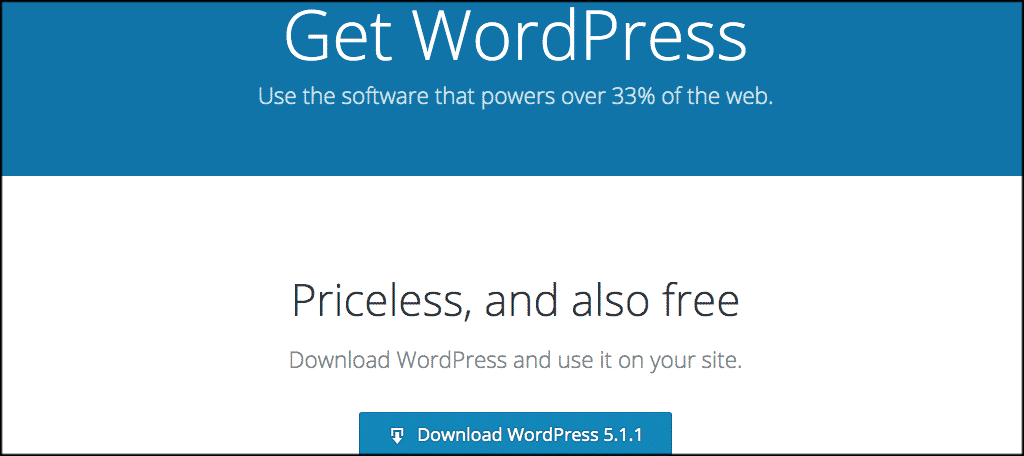
Save the file to a location on your computer. I would suggest saving it to the desktop as it makes the file easier to find when you’re ready to use it on your hosting platform.
Step 2: Uploading WordPress
After WordPress has finished downloading the zip file to your computer, you will need to upload the files to your hosting account, namely to your public_html folder.
Some of you may have more than one domain linked to your hosting account. If this is the case, make sure you upload the file to the correct directory.
There are two ways to upload the files for WordPress hosting:
Either of these systems will work just the same for uploading your .zip file. I prefer to use cPanel simply because it doesn’t require installing a program to use it. However, using FileZilla does have its advantages, such as giving you a program that can help make local backups of your website.
Using FTP client
File Transfer Protocol, or FTP, is a useful tool when you want to dig into developing a website. To use FileZilla or another FTP program, you will need to unpack the zip file onto your computer. Then, you’ll upload all of the files to the correct directory on your hosting account.

The overall process of FTP for setting up WordPress is a bit more time-consuming than using cPanel’s File Manager. But if you’re looking to put in a bit of extra work for programming development or need to create a copy of your site, programs like FileZilla are ideal.
Using File Manager
File Manager is built with a wide range of tools. One of the reasons why I prefer this method to FTP applications is because it is accessible from virtually any web browser.
From cPanel, click on File Manager.

Access the directory you want to use by clicking, “public_html.”

Once you’re in the correct directory, click the “Upload” option in the toolbar.

You will click the “Select File” and upload the .zip you downloaded from WordPress.org. Once the upload is complete, click the “Go Back to…” link at the bottom.

Select the WordPress file and click “Extract” in the toolbar. You can select the file by clicking it once with your mouse.

A new window will appear asking where you want the files extracted to. In this instance, you’ll leave the default directory that is shown. Click the “Extract File(s)” button to unpack the .zip.
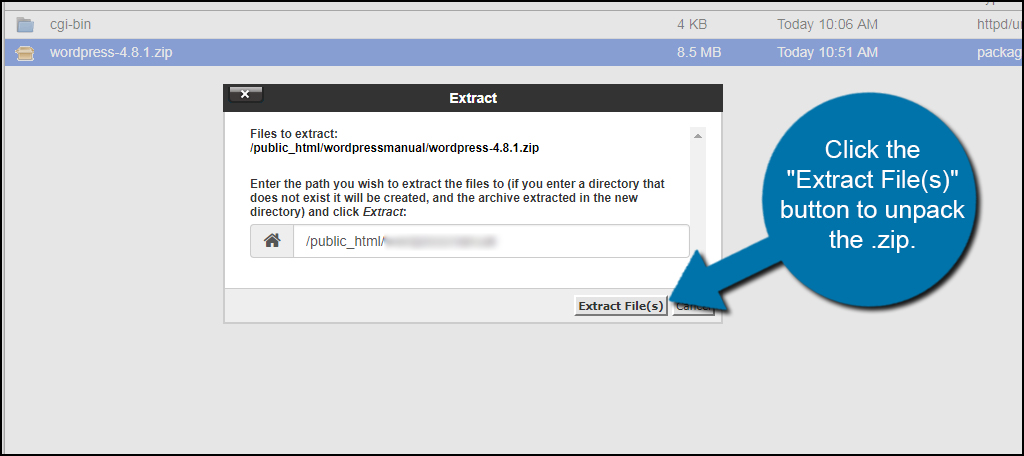
Because of how the .zip file is set up, you’ll see a “WordPress” folder in your directory. We’re going to move the contents of this folder so we can continue the installation properly.
If you don’t move the files, your website will be located at “https://www.ggexample.com/wordpress” (replace “ggexample.com” with your domain). It’s not very attractive this way and may be confusing for some visitors.
Click into the “WordPress” directory to show its files. You can use double-click to do this.
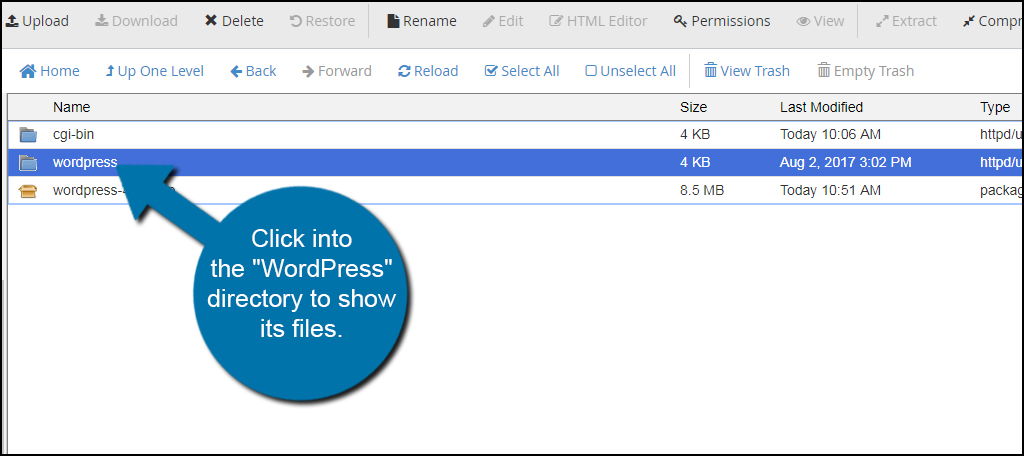
Select all of the files and folders and click “Move.” If you have a PC, you can click the top folder and then hold down CTRL while clicking the last file. Mac users can use the Command key.

A new window will appear for moving all of the files and folders. Remove the “wordpress” part of the directory. It will be at the end of the path. If you only have one domain name, then your file path should look like “/public_html/.”

Click the “Move File(s)” button once you’re ready.

When the files are moved, click the “Up One Level” button to return to your site’s directory.
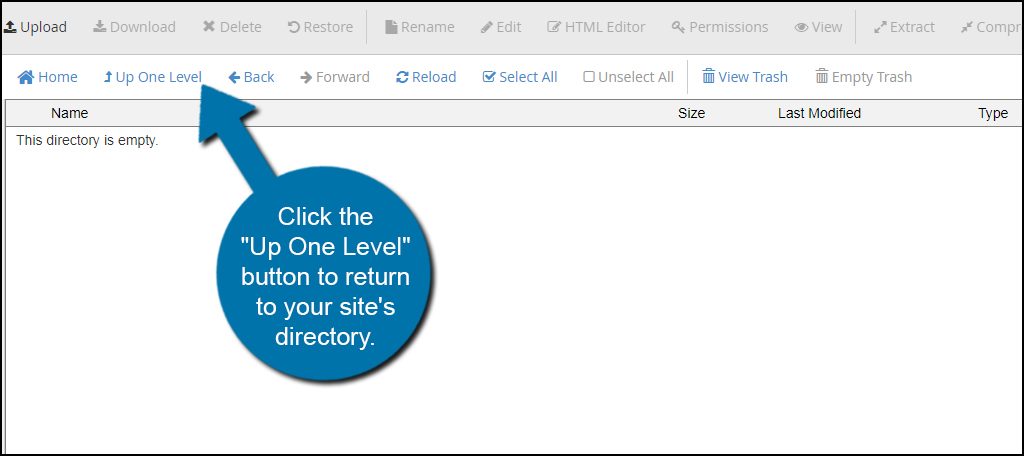
Setting Up the Database
Before you begin with the actual installation, you will need to create a database on your hosting account. This will allow WordPress to save data needed for the website to function.
From the cPanel dashboard, click the “MySQL Database Wizard” tool.

Give your database a name and click, “Next Step.” Keep it something simple and easy to identify. For instance, I’m going to use “wp007.”

Assign a username and password. This will be how your WordPress website will connect to the database. Avoid things like “admin” when creating a username. For this tutorial, I am going to call it “connector” and use the Password Generator.
Take note of the:
- Database name
- Username
- Password
You will need this information in the next step.
When you’re done setting up the information, click the “Create User” button.

In the next screen, you’ll assign privileges for this account. Because this is the main access point for WordPress, it needs to have everything. Click the “All Privileges” checkbox.

Scroll to the bottom and click, “Next Step.”

Your database is now ready for WordPress to use it. Make sure you copied down your database name, user and password correctly.
Step 4: Installing WordPress
Next, we will set up your blog. To do this, head over to https://www.ggexample.com/wp-admin/install.php. If your blog is in a subdirectory, then go to https://www.ggexample.com/subdirectory/wp-admin/install.php instead.
The first screen is a language selection window. Choose your primary language and click, “Continue.” English may already be selected by default depending on the version of WordPress you downloaded from the developer’s website.

The next screen tells you the elements you’ll need to know before installing WordPress. This is the same information I told you to take note of earlier. Click the “Let’s go!” button on the bottom left.

Insert your database name, username, and password. Leave the “Database Host” as localhost. This will work with the majority of web hosts including GreenGeeks. If “localhost” doesn’t work for you, then you’ll need to get the info from your hosting provider or customer support.
Leave the “Table Prefix” untouched as well, unless you plan on running multiple installations of WordPress in a single database.
Take into account the prefix to your database name and username. Usually, this will start with the primary account name. It will look something like, “accountname_” complete with the underscore. This is visible when you’re setting up the database.
Click “Submit” after you’ve entered the information.

On the next screen, click the “Run the Install” button to continue.
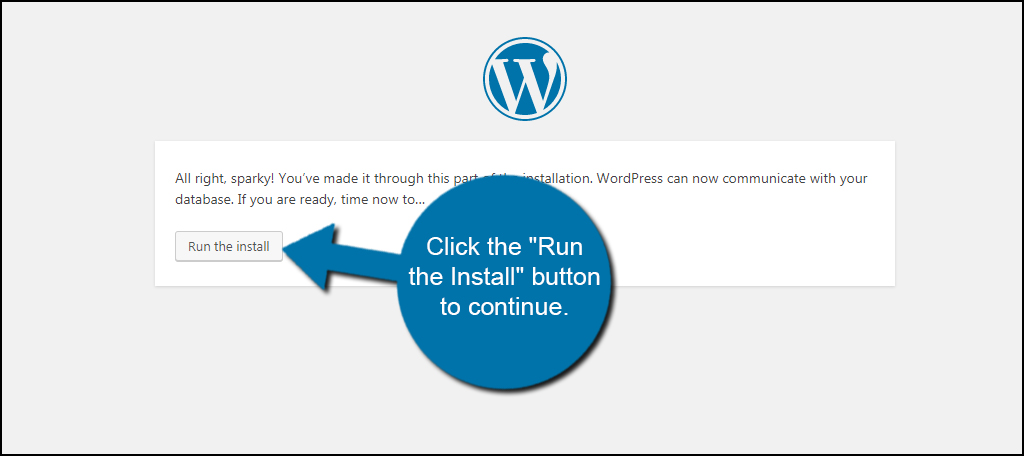
You will need to enter some admin information. Input the title of your site, the admin username, password, and your email address. It’s best that you do not use “admin” for the administrator account. It’s one of the first things bots and hackers attempt when trying to gain access to any website.
Make a note of your username and password. You will need these to log in to your WordPress Dashboard to manage your site.
Once you’ve entered your information, click the “Install WordPress” button on the bottom left.
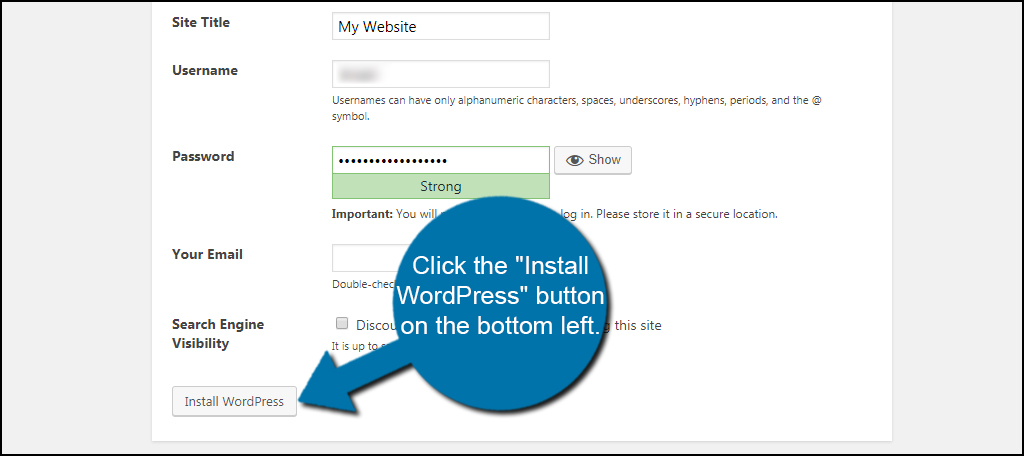
Congratulations, you have set up your site. All you need to do now is click the “Log In” button and start creating content.

That’s how you install WordPress manually.
How to Install WordPress with Softaculous
Softaculous is an application installer that automates setting up various management systems. In this case, it will install WordPress and its database after just a few pieces of information from yourself. It’s a quick and easy way to set up a website without having to learn a single line of code.
I’m going to show you how to install WordPress with Softaculous. In mere moments, you can start promoting your website and begin building something spectacular.
Step 1: Open the Softaculous App Installer
With GreenGeeks hosting plans, you’ll have access to cPanel. This is a versatile administrative dashboard that gives you control over many aspects of your website.
From cPanel, scroll to the Softaculous Apps Installer and click “WordPress.”

Step 2: Install WordPress
From the Softaculous script window, click the “Install Now” button in the description. The Softaculous software will usually have the most recent version of WordPress available. If you want to install an older version, you may have to do it manually.
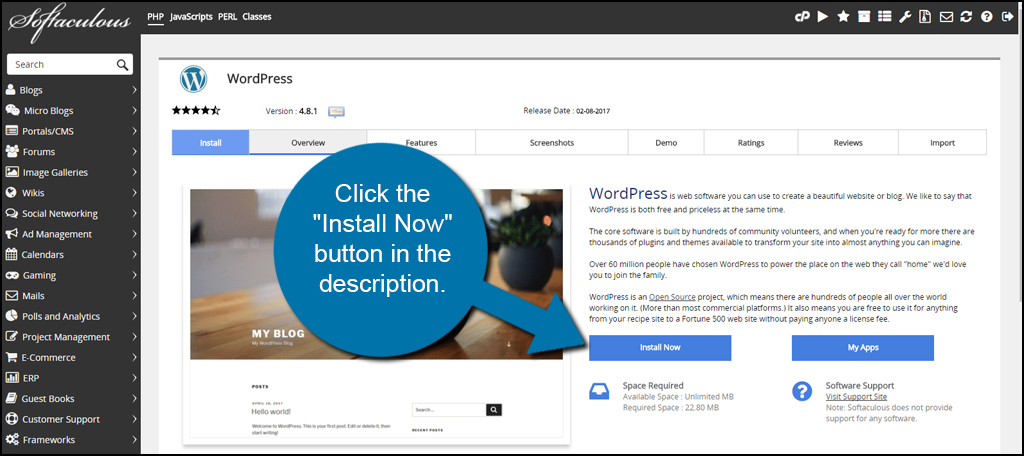
In the next screen, you will need to input all of your website’s settings. Let me break them down a bit for you:
- Software Setup
In this section, you’ll choose whether your site uses SSL protocols or not. This is done by selecting which “http:” version you want to use from the drop down options. You’ll also pick your domain. If you only have one domain name, it will be displayed automatically. Otherwise, you’ll have to select it from the list. - Site Settings
This is the basic information of your website. You’ll put in your site’s name and a short description. This will be used by most themes as well as the WordPress system for identification purposes. It will also play a part in search engine optimization, so make sure the information is something you want seen in sites like Google. - Admin Account
Input the admin username and password you want to use to log into WordPress. I suggest never using the name “admin” as the administrator username. It’s the first thing bots and hackers will try when attempting to access your website. Make it something completely unique to you. - Admin Email Address
This address is only used by WordPress itself and is not available publicly. Plugins you install may also use this address to send you messages or updates. It can also be used for password recovery should you forget or lose your login credentials. - Choose Language
This is set as English by default. However, you have the option of using many different language types for WordPress. Choose one that is ideal for you and your website. - Select Plugins
Softaculous often comes with a couple of Plugins readily available should you choose. GreenGeeks displays “Loginizer” and “WPForms Lite.” These two plugins are very helpful for those who want to protect the login screen and create forms such as what you would use for contact information. Click the check boxes to activate or deactivate these optional plugins. - Advanced Options
Advanced options are for those who have a firm grasp of databases, upgrades and backup control. You can customize these elements if you wish, but I would suggest new users to leave these settings. - Select Theme
WordPress comes with a few themes readily available. These files dictate how your website appears. In Softaculous, you can choose from a wide variety of layouts. Simply click the one you want to install with WordPress and Softaculous will do the rest. Please note that you can change themes at any time and as often as you like.
NOTE: At the bottom of the screen, below the “Install” button, you can assign an email address to send installation details. It may be helpful to have a record of the process. However, this is completely optional.
Once you’re done fine-tuning WordPress, click the “Install” button on the bottom middle of the screen.

Softaculous will then analyze your information and settings while installing the WordPress CMS onto your website.

After the installation is complete, Softaculous will give you a couple of links. One is the URL of your new website while the other is the admin address. Click the link next to “Administrative URL” to visit the login screen and access your site.

Bookmark this URL so you can find it easier at a later date.
After you install WordPress, it’s time to get started creating content and building an attractive site people will love. Whether you want to start a blog to make money or plan on selling products from an online store, WordPress is a strong platform to use. Get your creative juices flowing and design the next biggest online craze.
What kind of a website are you planning to design? What kind of plugins do you prefer when setting up your site for the first time?

how long to install that the wordpress?
Depending on the server and the speed in which DNS distributes the domain name, you can install and start using WordPress in just a few minutes. What takes the longest is waiting on DNS to propagate throughout the Internet. Depending on ISPs, this can take anywhere from five minutes to 48 hours. Installing WordPress itself, though, takes maybe five minutes total.